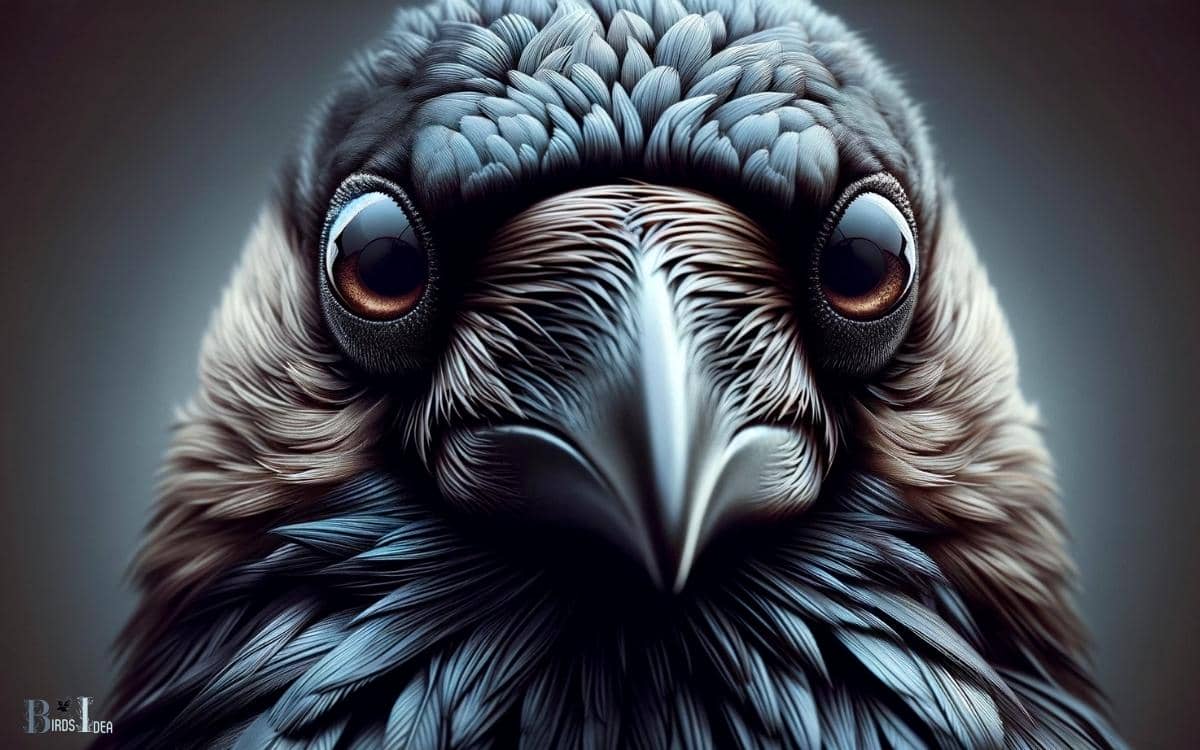What Color Are Crows Eyes: Black!
Crows typically have dark brown to black eyes, which match their glossy black plumage.
The eye color of crows may appear to shift slightly in different lighting conditions due to the reflection of light on the cornea.
The color of a crow’s eyes is a result of the pigmentation in the iris, which is generally dark brown to black. This pigmentation helps to reduce glare and allows for better vision in bright sunlight.
Crows are known for their intelligence and sharp vision, which is essential for their survival in various environments.
- Eye Color: Dark brown to black
- Function: Reduces glare, improves vision in sunlight
- Significance: Aids in survival and foraging
Discovering the hue of crow’s eyes provides insight into their adaptation and ecological success, revealing the beauty and complexity of these intelligent birds.

Key Takeaway
The Anatomy of Crow Eyes
The anatomy of crow eyes is a complex and intricate subject that encompasses the structure and function of the ocular organs in these avian species.
Crows have large, highly developed eyes that provide them with excellent vision, allowing them to navigate their surroundings with precision.
Their eyes are positioned on the sides of their heads, giving them a wide field of view to detect potential threats or sources of food.
Crows have a high density of photoreceptor cells in their retinas, which enables them to perceive details and colors vividly.
The eyes of crows are adapted to their diurnal lifestyle, providing them with keen eyesight during the day.
Understanding the intricate design of crow eyes sheds light on their remarkable visual capabilities.
This leads us to the subsequent section about ‘myths and misconceptions’ regarding crow eyes.
Myths and Misconceptions
There are several myths and misconceptions surrounding the color of crow eyes. Some believe that all crow eyes are black, while others claim they can be blue or red.
It is important to address these misconceptions and explore the actual range of eye colors present in crows to dispel any false information.
Crow Eye Color Myths
Crow eye color myths persist despite scientific evidence debunking misconceptions about their eye color.
These myths often stem from folklore and superstitions, but it’s important to separate fact from fiction.
Here are some common myths about crow eye color:
- All crows have black eyes: While many crows do have black eyes, some species actually have brown eyes, which can lead to misconceptions about their eye color.
- Crow eye color indicates their behavior: There is no scientific evidence to support the idea that crow eye color is linked to their behavior or personality traits.
- Crow eye color changes with age: Contrary to popular belief, crow eye color does not change as they age. It remains consistent throughout their life.
- Albino crows have red eyes: This is a common misconception, as albino crows actually have pale blue or gray eyes, not red.
It’s important to rely on scientific evidence rather than perpetuating myths about crow eye color.
Eye Color Misconceptions
Eye color misconceptions abound in popular beliefs and folklore, often perpetuating myths about the true colors of crow eyes.
One common misconception is that all crows have black eyes. However, depending on the species, crow eyes can vary in color from dark brown to gray.
Another prevalent myth is that eye color can indicate a crow’s age or mood. In reality, eye color in crows, as in many other species, is not indicative of age or emotional state.
Additionally, some people believe that crows with lighter eye colors are a different species altogether, but this is not the case.
These misconceptions highlight the importance of seeking accurate information and dispelling myths to better understand the fascinating world of crow eye colors.
The True Color Revealed
The true color of crows’ eyes has been revealed through recent scientific research. Contrary to popular belief, crows’ eyes are not just black.
The findings of the study, published in the Journal of Avian Biology, have astonished researchers and bird enthusiasts alike.
Here are some key discoveries:
- Iridescent: Crows’ eyes contain iridescence, giving them a mesmerizing appearance when exposed to light.
- Blue Hue: Under specific lighting conditions, the eyes display a stunning blue hue, challenging the traditional notion of black eyes.
- Variable Pigmentation: The color of crows’ eyes can vary based on environmental factors and age, leading to a spectrum of shades from deep blue to almost black.
- Intriguing Adaptation: This revelation sheds light on the remarkable adaptations of these intelligent birds, sparking further interest in avian vision and behavior.
Adaptations for Survival
Adaptations for survival in crows include their remarkable ability to thrive in diverse environmental conditions and their complex social behaviors, which have been the subject of extensive study in avian biology.
Crows exhibit a range of physical and behavioral adaptations that contribute to their success in various habitats.
| Physical Adaptations | Behavioral Adaptations |
|---|---|
| Exceptional intelligence | Cooperative hunting |
| Versatile diet, including scavenging | Complex communication through vocalizations |
| Strong, hooked beaks for foraging | Ability to recognize and remember human faces |
| Excellent problem-solving skills | Formation of close-knit family groups |
These adaptations enable crows to exploit a wide array of ecological niches and interact effectively with their surroundings, demonstrating their capacity to thrive in ever-changing environments.
Vision and Perception
Crows rely on their keen visual acuity to perceive and navigate their surroundings efficiently. Their vision and perception are crucial for their survival and success in their environment.
Here are four key aspects of crow vision and perception:
- Color Vision: Crows have the ability to see a wide range of colors, enabling them to identify various food sources and potential threats more effectively.
- Depth Perception: Their eyes are positioned in a way that provides them with excellent depth perception, allowing them to accurately judge distances and make precise movements, crucial for tasks such as hunting and navigation.
- Visual Memory: Crows have impressive visual memory, enabling them to remember landmarks and locations of food sources, helping them thrive in their habitats.
- Low-Light Vision: Crows have exceptional low-light vision, allowing them to remain active during dawn and dusk, when light levels are low.
Cultural Significance
Crows’ eyes have significant cultural importance, reflecting a diverse range of symbolic interpretations across various societies and belief systems.
In many cultures, crows are associated with magic, mystery, and intelligence, and their eyes are often viewed as a window to their mystical abilities.
For example, in some Native American traditions, crows are seen as messengers and are believed to have the ability to travel between the physical and spiritual worlds.
As a result, their eyes are regarded as a symbol of insight and connection to the unseen realms.
Similarly, in other cultures, crows’ eyes are linked to foresight, wisdom, and the ability to see beyond the surface.
The cultural significance of crows’ eyes serves as a reminder of the rich tapestry of beliefs and interpretations that exist across the world.
Caring for Crow Eyes
When caring for crow eyes, it is important to consider their unique anatomy and specific visual needs to ensure their well-being. Crows have remarkable vision, and proper care is essential to maintain their ocular health.
Here are some key considerations for caring for crow eyes:
- Regular Veterinary Check-ups: Schedule routine check-ups with an avian veterinarian to monitor their eye health and address any potential issues.
- Balanced Diet: Provide a balanced diet rich in essential nutrients, including vitamin A, to support optimal eye function.
- Environmental Enrichment: Create an enriched environment with perches, toys, and natural elements to stimulate their visual senses and prevent boredom.
- Monitor for Signs of Eye Disease: Keep a close watch for symptoms of eye disease such as cloudiness, discharge, or changes in behavior, and seek prompt veterinary care if any issues arise.
Conclusion
The true color of crow eyes is a deep, dark brown, which provides them with excellent vision for their scavenging and hunting activities. Contrary to popular myths, their eyes are not actually black.
Their keen eyesight and ability to perceive the world around them make them highly adaptable and successful creatures.
Understanding the anatomy and function of crow eyes can provide valuable insight into their behavior and survival strategies in various ecosystems.





